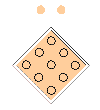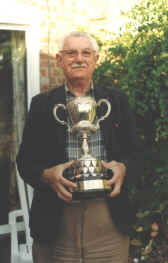londonskittles.co.uk


| Home | News | About London Skittles | Members Section | History of the Game | Links | Glossary |
londonskittles.co.uk |

|
 |
||||||
|
||||||||
|
Historical Connections Flinders Petrie, the Egyptologist and resident of Cannon Place, Hampstead, was responsible for discovering some small childrens' toys found in Egypt. These date back some 5,000 years and show a close affinity with present day bowling games. The author A.P.Herbert was a keen London Skittler. In his book The Water Gypsies he devoted a whole chapter (The Christmas Cup) to a superlative description of a game. He also reported on the 1948/49 Individual Championships in Punch magazine which F.G.deB. Hart (pictured below) won in an exciting final against Arthur Lambert.  F.G.deB. Hart on 16th November 1999 with the cup he won over 50 years previously. [Picture: Guy Tunnicliffe] One of the places where skittles was played early in the 20th century was the Drayton Court Hotel in West Ealing. In 1919 a Vietnamese man called Nguyen Van Thanh worked there as a cook. It is fascinating to speculate whether he saw or even played the game of London Skittles. More fancifully, did what he learned from the game aid his military strategy when, in 1954 and now known as Ho Chi Minh, he kicked the French out of his native country? A picture of a man playing London Skittles appeared on the BBC TV News as part of the 1997 General Election coverage. UK voters will remember "the man in the white suit", the former BBC journalist Martin Bell, who stood as an independent candidate against Neil Hamilton on an anti-sleaze ticket. The Nine O'Clock News ran a background feature on the last Independent MP to be elected to an English seat, none other than A.P.Herbert who represented Cambridge University in Parliament until the university seats were abolished in 1951. They showed several pictures of him, including one in which he had just launched a cheese in a London Skittles game. |
A Brief History of SkittlesThe history of the game can be traced back, alongside other similar games, to Ancient Egypt and perhaps beyond. Other ancient references include both Greek and Roman examples as well as the Lydians of Southern Turkey. No one bowling game can claim to be the only game with an absolute pedigree. Bowls, skittles in various forms, ten pin bowling and a host of other games where an object is thrown at a set of pins or balls could all be descended from some of the games played in the ancient world. Regarding its history in England, there are once again competing arguments as to origin and provenance. Variations have been described in both literature and in books on the games and pastimes of this country. Some maintain that coloured pins were used, denoting different members of the Royal Court and each having differing values. Others show evidence of Low Country origin, such as 'Dutch pins' or games akin to 'Kegel' from Germany and 'Quilles' from France. Both the objects thrown and the objects hit vary from the thigh bones of various animals to logs of wood ('loggats' in Shakespeare). The London game, also known as Old English Skittles, may have been brought over by seafarers from the Netherlands. Certainly the pubs where it was played were clustered about the River Thames. The game was formalised towards the end of the nineteenth century with club constitutions being drawn up and an Amateur Skittles Association being formed. The heyday of London Skittles was between the wars when large numbers of clubs played in competitions. Our alley owes its present position to the former landlord Bernard Levy, who brought skittles in from the cold. He ordered a specially constructed basement room in the cellar of the Freemasons' Arms when the premises were rebuilt in 1933. Prior to this the game had been played in a garden outhouse of the original public house, which was built in 1819. The standard of play in the 20's and 30's was high. A roll of honour, now sadly lost, used to hang in the alley at Hampstead. It recorded every occasion when three successive floorers had been thrown. The peak was in 1934 when this was achieved seventeen times. On the odd occasion four or even five successive floorers were recorded. After the Second World War, three successive floorers were recorded only twice, once in 1946 and once in 1960 - and it hasn't been done since. After the war, London Skittles went into decline. It continued to be played in a number of pubs such as the Black Lion in Hammersmith and The Haven in Ealing. By the end of the 1970s only three clubs remained; Hampstead, the Aquatics who played at the Dukes Head in Putney and the National Westminster Bank who played at the company sports ground in Norbury. Now the game continues only at the Freemasons Arms. The unique position of the Freemasons' Arms in the world of skittles and its relevance to tenpin and other bowling games ensures a steady flow of interested visitors. Some may be searching for historical pegs on which to hang their own games, whilst others seek a demanding and robust pastime that involves exertion and beer drinking in one and the same venue. Guy Tunnicliffe and Paul Robinson |
A Lost Recreation Guy Tunnicliffe The first part of Guy's promised treatise on the game: - Word document (51KB) - PDF document (110KB) Left click the link to view. To download, right click and select Save Target As... The Adobe Acrobat Reader is needed to view the PDF document. If you don't have it installed, click the logo below to download it.  Skittles History on the Web History
of Traditional Games |